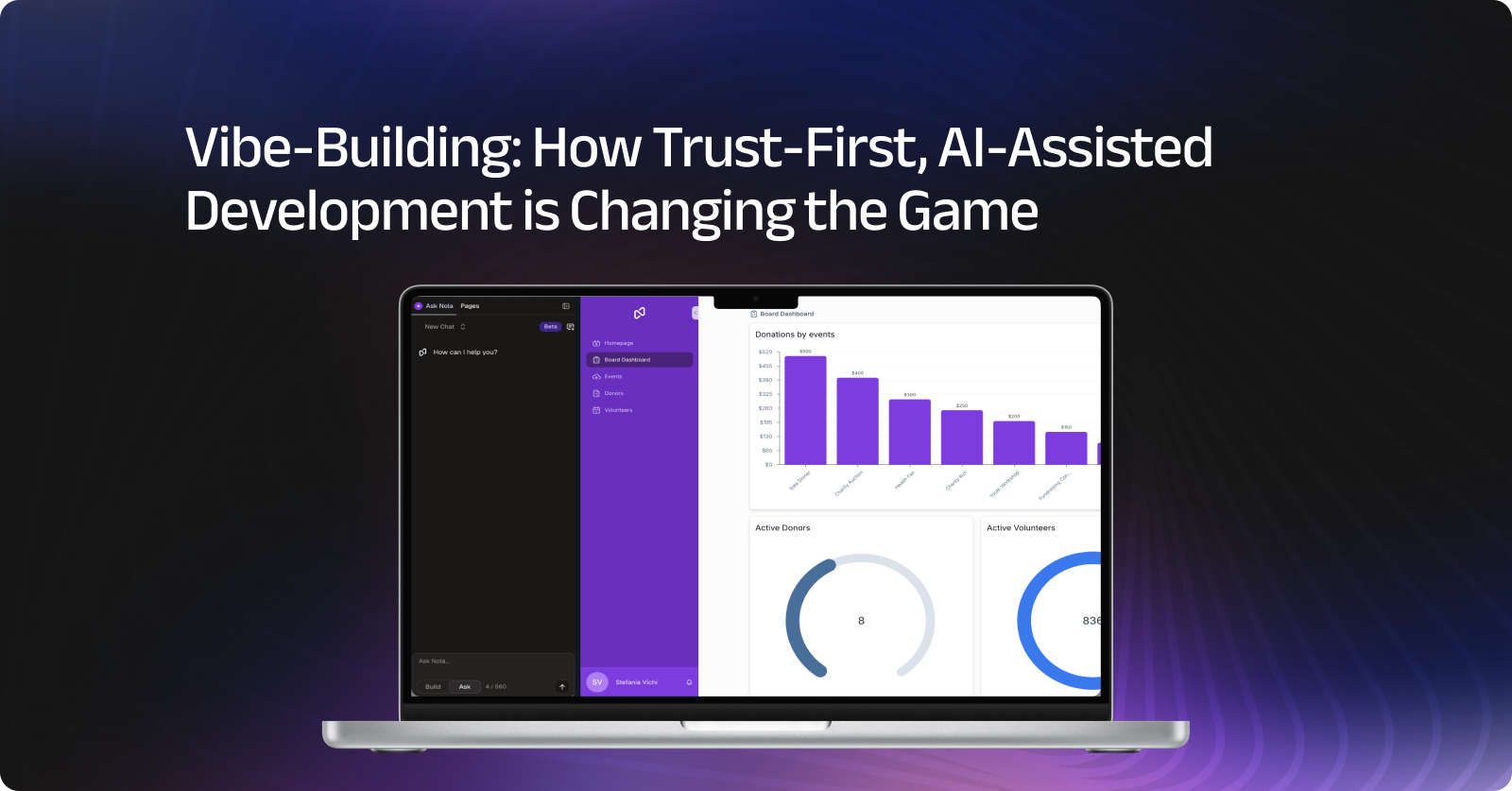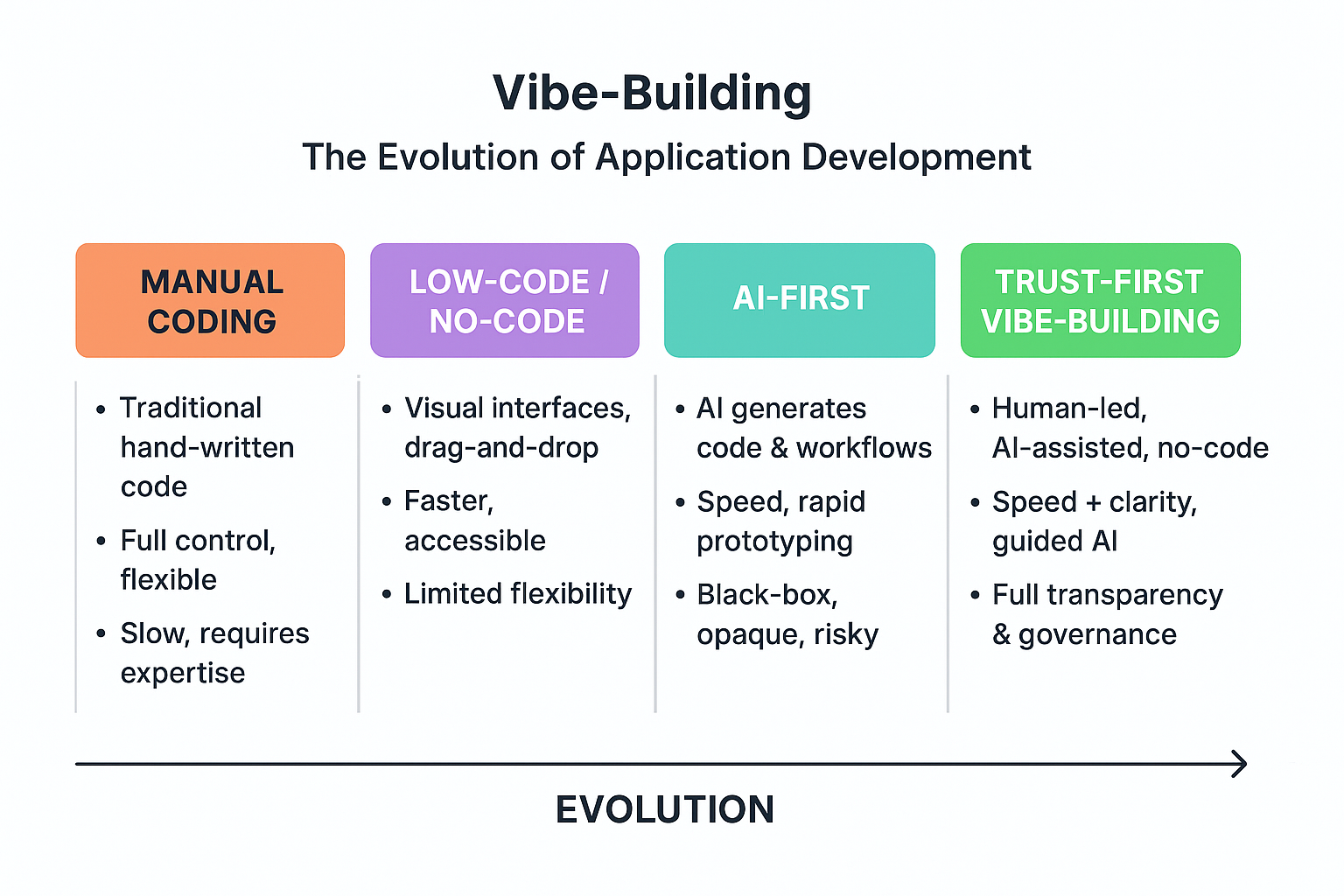Solutions
Platform
Resources

In this AI era, building software is no longer just about writing lines of code. The way teams create applications has shifted dramatically—from traditional coding to low-code/no-code platforms, and now to a new paradigm called vibe-building. Vibe-building is a human-led, AI-assisted approach that focuses on designing, orchestrating, and enhancing workflows and applications while keeping transparency and control front and center. Unlike opaque AI-first systems, vibe-building ensures teams can see, understand, and trust every step of their workflows, making it a game-changing approach for modern enterprises.
For decades, traditional software development relied heavily on manual coding, requiring specialized technical skills and long development cycles. While powerful, this approach often led to complex, hard-to-maintain systems and slower time-to-market. The rise of no-code and low-code platforms transformed the landscape by enabling non-developers to create functional applications visually, using drag-and-drop interfaces instead of writing every line of code. Platforms like those highlighted in Zapier’s list of best no-code app builders showcase how businesses can rapidly prototype, deploy, and iterate on workflows without sacrificing quality, while opening development to a broader audience.

As AI tools began generating code and automating workflows, development speed reached unprecedented levels. AI-first platforms promise rapid prototyping and even fully automated application creation, reducing the need for human intervention in routine coding tasks. However, this speed often comes at a cost: opacity and lack of visibility. Many AI-generated workflows operate as “black boxes,” making it difficult for teams to understand, audit, or trust the logic behind them. While AI-first solutions may accelerate delivery, enterprises increasingly demand transparency and control—ensuring that every workflow can be seen, understood, and governed.
n the AI era, trust has become a critical factor for adoption. Teams are hesitant to rely on systems they cannot fully understand or control, particularly when AI-generated workflows impact business-critical processes. Transparency is no longer optional—if users can see and understand a system, they are more likely to trust and adopt it. This is where the traditional AI-first approach falls short: without visibility, even highly capable AI tools can create friction, errors, or compliance risks. A trust-first development approach, where human oversight and clear workflow visualization are prioritized, ensures that AI augments human decision-making rather than replacing it blindly.
Vibe-building represents the next evolution of application development—a human-led, AI-assisted, no-code approach that combines speed, creativity, and control. Unlike AI-first systems that generate workflows opaquely, vibe-building emphasizes visibility, transparency, and governance, allowing teams to see and understand every step of the process. Humans guide and orchestrate AI agents, shaping workflows, user experiences, and business processes without losing oversight. In essence, vibe-building is about creating intelligent systems collaboratively with AI, while ensuring that teams retain full clarity and confidence in their applications.
In practice, vibe-building leverages visual no-code interfaces and AI-assisted tools to create workflows and applications quickly, while keeping humans in the driver’s seat. Platforms like Noloco, with its AI assistant Nola, enable teams to design, modify, and orchestrate workflows in a fully transparent and auditable way. Nola can suggest improvements, generate components, or automate repetitive tasks, but every recommendation remains visible and adjustable, ensuring that users maintain full control and understanding. By combining AI’s efficiency with human oversight, vibe-building allows teams to accelerate development without sacrificing trust, stability, or clarity.
Noloco takes vibe-building a step further with its Trust-First philosophy, ensuring that AI enhancement never comes at the expense of visibility or control. With Nola, the AI assistant, users can co-create workflows, automate processes, and receive intelligent suggestions—all while being able to inspect, modify, and govern every step. Unlike AI-first competitors that prioritize speed over transparency, Noloco empowers teams to see, understand, and trust their applications. This approach appeals to organizations that want the power of AI without the risks of black-box systems, offering clarity, stability, and control in every workflow.
The future of application development is moving toward AI-assisted, human-led, trust-first vibe-building platforms. As organizations demand faster innovation without sacrificing oversight, the combination of no-code interfaces, transparent AI tools, and human orchestration will become the standard. Platforms that prioritize visibility, auditability, and governance, like Noloco with its AI assistant Nola, will lead the market, enabling teams to build intelligent workflows and applications confidently. By 2025–2026, trust-first vibe-building is expected to define how businesses adopt AI in a way that balances speed, creativity, and control.
Noloco is perfect for small to medium-sized businesses in non-technical industries like construction, manufacturing, and other operations-focused fields.
Not at all! Noloco is designed especially for non-tech teams. Simply build your custom application using a drag-and-drop interface. No developers needed!
Absolutely! Security is very important to us. Our access control features let you limit who can see certain data, so only the right people can access sensitive information
Yes! We provide customer support through various channels—like chat, email, and help articles—to assist you in any way we can.
Definitely! Noloco makes it easy to tweak your app as your business grows, adapting to your changing workflows and needs.
Yes! We offer tutorials, guides, and AI assistance to help you and your team learn how to use Noloco quickly.
Of course! You can adjust your app whenever needed. Add new features, redesign the layout, or make any other changes you need—you’re in full control.